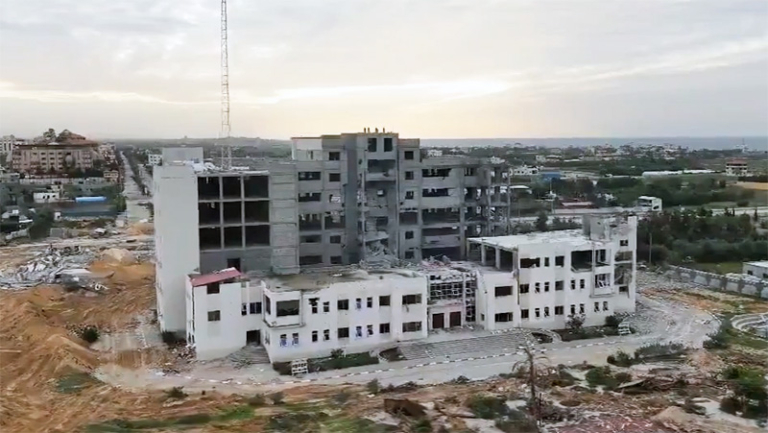
Palestinians’ experience with displacement, asylum, and dispossession since the Nakba in 1948 sparked what can be described as an educational revolution, leading them to become one of the world’s most skilled and educated societies. At the same time, the education sector in Palestine generally, and in Gaza in particular, has suffered from continuous targeting by the Israeli occupation. Israel’s ongoing genocidal war in Gaza has had massive human and infrastructure costs. It has destroyed schools, universities, and technical institutes and has killed large numbers of teachers and students in an apparent attempt to punish the Gaza Strip by depriving of the means to educate its inhabitants and to prepare them for the future.
The Current Scholasticide
Israel’s Gaza war has systematically and deliberately targeted the education sector with the intention of displacement and marginalization. Karma Nabulsi, an Oxford University scholar, first coined the term “scholasticide” to describe the willful demolition of educational infrastructure. This term was popularized during Israel’s 2008–2009 invasion of Gaza. Researchers today argue that the Israeli army’s current attack on educational institutions in Palestine is a clear example of scholasticide, part of a well-established and long-standing pattern of deliberate assaults against the creation of knowledge and cultural heritage carried out as part of colonial occupation policies to deter the Palestinians from resisting. The ongoing war since October 7 is the worst in terms of destruction and loss, particularly in the education sector.
Israel has inflicted three main types of losses on Gaza’s education sector.
Physical destruction of educational institutions. Israeli bombings have destroyed all twelve of Gaza’s higher education institutions, or portions of them, most recently Al-Israa University. Brigadier General Barak Hiram, the military officer who ordered the destruction of the university, was merely censured for his actions, purportedly for not getting the required permission from military authorities. In fact, Israeli Prime Minister Benjamin Netanyahu is said to be promoting Brigadier General Barak Hiram, despite stories that he was responsible for killing 13 Israeli citizens on October 7 while responding to the Hamas attack of that day.
Abdel Razzaq Takriti of Scholars Against the War on Palestine described conditions in Gaza as a “total annihilation of Palestinian education.” Indeed, entire educational institutions have been demolished, wiping out decades of educational progress and leaving behind only memories of what once was. This loss has not only affected the physical infrastructure but has also erased invaluable resources and knowledge accumulated over the years.
As of early February, hundreds of thousands of internally displaced persons were using some 92 per cent of all school buildings in Gaza as shelters, despite clear evidence of varying degrees of damage. The Education Cluster (EC), a consortium of United Nations partners, reported in February that 386 school buildings, or 78 percent of all schools in Gaza, had sustained damage, with 25 schools fully damaged, 113 severely damaged, 125 with moderate damage, and 123 with minor damages. According to the BBC, an EC study of the damaged sites found that actual destruction might be as much as 20 percent higher than reported.
Killing of educators. The Palestinian Ministry of Education reported that as of February 26, more than 800 teachers had been injured and more than 239 staff members had been killed since October 7. Euro-Mediterranean Human Rights Monitor (Euro-Med), a Geneva-based NGO, reports that targeted attacks have killed many academics in Gaza, especially those with advanced degrees. Three university presidents have been targeted since October 7, along with more than 95 university deans and professors, Euro-Med found. The true extent of these losses remains unknown, as many deaths likely go unrecorded. In its latest statement, on February 19, the Ministry of Education announced that 5,213 students have been killed and 8,691 injured since the onset of the aggression in October 2023.
5,213 students have been killed and 8,691 injured since the onset of the war in October 2023.
Destruction of culture and heritage. Israel’s assault has extended to museums, libraries, and archives. Many such places have been destroyed, damaged, or looted, with priceless historical documents, manuscripts, and artifacts demolished.
Some scholars are not convinced that the current definition of scholasticide is sufficient to cover the ongoing atrocities against the education and culture sectors in the Gaza Strip. Academics Against War on Palestine, for example, has argued that the term should be broadened to include deliberate injury to administrators, teachers, and pupils; impeded access to education; and systematic attacks such as besieging, shutting down, or obstructing access to educational institutions. All of this is cultural erasure, which is a form of cultural genocide perpetuated when cultural heritage is purposefully destroyed.
Considering such scholars’ arguments and analyzing data from several credible sources, they are on the right track to expand the scope of the term. Indeed, the Ministry of Education in Gaza halted the 2023-2024 academic year due to security and safety reasons. As of November 6, students have been unable to resume their studies.
Destroying Education Is Part of a Plan
Why is Israel conducting this assault on the Palestinian educational sector? Many reasons come to mind.
- Arresting social advancement: All educational institutions, including schools, universities, and cultural centers, preserve Palestinian national identity and foster personal and intellectual development, facilitating Palestinians’ global advancement. Palestinian scholar Rami Khouri put it succinctly, writing that “[T]he first generation went to work, the second generation went to education, and the third generation will go into action.” Israel aims to set back the Palestinian people to the pre-education stage, focusing solely on providing the basics for survival.
- Attacking UNRWA. Attacking the education sector is a way of obstructing and constraining the work of UNRWA, which has been a major contributor to educating the Palestinians.
- Perpetuating Gaza’s dependency. The deliberate destruction of diverse and highly skilled human capital, coupled with the relentless targeting of educational infrastructure and the assassination of scholars, serves the sinister purpose of perpetuating Gaza’s subservience to Israel and its oppressive conditions. This strategy not only stifles any prospects for developmental autonomy but also perpetuates Gaza’s entrapment in a vicious cycle of dependency, where the continuous need for aid, including vital necessities like food and medicine, leaves no room for advancement or progress.
- Stifling Palestinian intellectual development. The deliberate destruction of educational infrastructure aims to hinder and stifle Palestinian intellectual development. The targeted killing of academics and professionals in fields like medicine, journalism, and engineering, along with strict surveillance of those working in areas such as technology and engineering, stems from fear of the Palestinian educational system producing talents that could challenge Israeli dominance scientifically and intellectually.
- Suppressing the Palestinian narrative. Education plays a crucial role in shaping the Palestinian narrative. The Palestinian education system produces a generation that unequivocally rejects occupation and exposes Israel’s crimes globally. This threatens to undermine the Israeli narrative. Israel’s killing in December 2023 of Gazan professor and poet Rafaat Al-Areer, who had eloquently addressed the world in English about the Palestinian experience under Israeli rule and occupation, is one horrifying example of how Israel uses violence to suppress the Palestinian narrative.
Rebuilding the Future: Education in Postwar Gaza
After the current war ends, Gaza’s educational community will face significant challenges, including the reconstruction of the educational infrastructure and addressing the psychological needs of affected students and educators. Many Palestinian academics, including Professor Kamalain Shaath, president of the Islamic University in Gaza, believe that restoring the educational sector in the Strip will be a multifaceted process that must start as soon as the war stops. Such a process should start with clearing the rubble and repairing whatever is salvageable.
The provision of tents and prefabricated buildings for educational activities, equipped with necessities and logistical services, should follow. Student and academic staff hours will need to be adjusted to accommodate as many students and disciplines as possible. Safety assessments will need to be conducted for partially damaged buildings, allowing classes to resume and providing a psychological boost to students. While educational quality may be compromised, this step is crucial. Students will need access to temporary halls for self-study and logistical services.
This would be followed by comprehensive reconstruction and restoration of university buildings and facilities to their pre-war state. The shortage of educational staff due to casualties should be addressed through a public call for Gaza-based academics abroad to return and resume teaching. Online teaching may be utilized if internet access is restored with reasonable quality. Strong contributions from West Bank universities will also be needed to fill the educational staff deficit. The focus will be on using available teaching materials, with subjects requiring laboratories and equipment deferred until they become available.
Strong contributions from West Bank universities will be needed to fill the educational staff deficit.
The success of this plan will rely on overcoming financial constraints, the complex political situation, and security challenges. It emphasizes the importance of cooperation among the government, international organizations, and civil society. By addressing the immediate needs of students and educators while laying the groundwork for long-term recovery, the plan represents a crucial step toward rebuilding a brighter future for Gaza through education.
Despite the relentless onslaught, systematic destruction, deliberate targeting of education, Gaza’s indomitable spirit prevails and its commitment to education to build national independence remains strong. Indeed, ending the war is not sufficient for recovery and resuming the educational process. What is needed is a Palestinian national plan that focuses on elevating the individual and the community in the service of the Palestinian national project of freedom and independence.
The views expressed in this publication are the author’s own and do not necessarily reflect the position of Arab Center Washington DC, its staff, or its Board of Directors.

